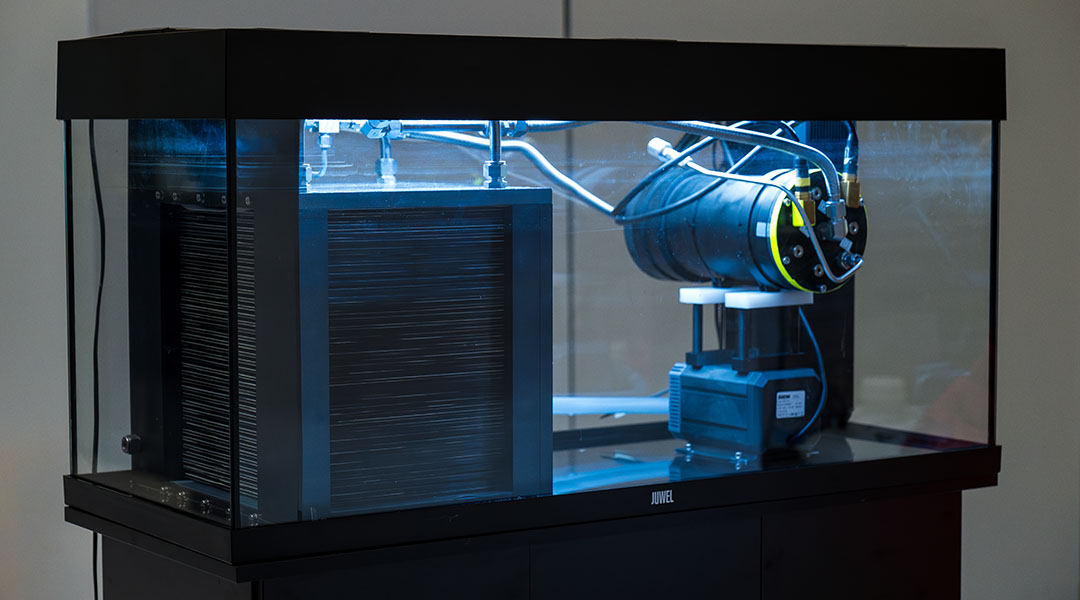New research tests a prototype fuel cell equipped with an artificial gill taking its inspiration from nature, which could revolutionise autonomous underwater vehicles and the way the science of oceanography is done.
Advances in underwater robotics have led to a massive increase in the use of autonomous underwater vehicles (AUVs), particularly in the field of observational oceanography. Over the last 20 or so years, a global network of profiling Argo floats and ocean gliders has gathered a vast amount of situ data regarding the varied processes at play in the world’s oceans and coastal seas.
Currently, these AUVs are powered by batteries ranging from high-energy-density lithium primary cells to low-cost alkaline cells to rechargeable lithium-ion batteries. An alternative to batteries is Proton Exchange Membrane fuel cells, which use hydrogen and oxygen as reactants and can have around three times the energy density of lithium primary batteries. However, when applied to underwater vehicles, oxygen must be stored onboard the vehicle, and this requires protective walls that can withstand oceanic pressures, impacting both the weight of AUVs and their volume.
A new way forward
New research published in the journal Advanced Science suggests a new way forward for AUVs. It proposes a revolutionary fuel cell fitted with artificial gills that could harvest oxygen from water. This frees up space for the hydrogen also needed by this rechargeable fuel cell.
“More energy and lower operational costs are the two keywords here,” said research co-author Lucas Merckelbach, scientist at Helmholtz-Zentrum Hereon. “Ocean-going research is logistically complicated and expensive. AUVs are usually not cheap to run. Batteries are expensive, as are deployment and recovery operations. With an increased operational time, this fuel cell power supply system can reduce the costs of oceanographic data.”
Merckelbach and co-author Prokopios Georgopanos, envisage that the main uses for this power system will be to power small AUVs and underwater sensors that are commonly used for observation
platforms in oceanography and related fields, and in applications
where the host of the power system does not have direct access to the
atmosphere.
“The use of fuel cells underwater is, in fact, not very common, because of the problem of access to oxygen,” Georgopanos explained. “Our system is unique in the sense that the oxygen is extracted from the ambient water. For smaller underwater devices, such as underwater robots, we think that this is the only way to design a power system using a fuel cell that contains enough energy, read hydrogen, to make it a viable alternative to batteries.”
Testing a fishy fuel cell
Hydrogen and oxygen gases can be chemically combined to form water, an exothermic reaction, meaning some of the chemical energy can be converted into other forms of energy. If hydrogen is “burned”, then only heat is produced.
However, if a hydrogen fuel cell is used to combine the hydrogen and oxygen gases, then most of the available chemical energy can be converted into electrical energy and a bit of heat, whilst only producing water. The electrical energy can then be used to power electrical devices, just like batteries do. The team proposes a fuel cell power supply system that uses a system of membranes to extract oxygen from ambient water.
“Effectively, this means you could have a cavity underwater, sealed by such a membrane, and water would not ingress into the cavity. However, oxygen molecules that are dissolved in water could pass this membrane, and in fact will do so, as soon as the oxygen concentration in the water is higher than the oxygen concentration inside the cavity,” said Georgopanos. “Now, we can put a fuel cell in this cavity together with a hydrogen supply, and the fuel cell will consume the oxygen, as it would when exposed to the atmosphere.
“Fish do something similar: they use gills to extract oxygen from the water to keep their metabolism running. The membranes in our system function like artificial gills.”
The team built a prototype with off-the-shelf materials and an artificial gill system comprised of 38 flat-sheet membrane frames stacked on top of each other with space for water to flow between them and channels to maintain an air stream.
The system didn’t perform as well as the team had calculated, but this could be because these calculations assumed a uniform air flow between all the membrane frames, which doesn’t reflect the real air flow in their underwater experiment. The fuel cell didn’t provide enough energy to an ocean glider, but this isn’t a major setback for the system, as this proof of concept represents the first steps on the team’s journey.
“Assuming that the system will work as efficiently as envisaged, it has the potential to revolutionise the way oceanography is done,” Merckelbach said. “When looking towards the future, we expect new technology to result in a 50% increase in hydrogen storage capacity using metal hydrides, more than a 5% increase in the energy content in lithium batteries. Fuel cell-based power systems will then even more widen the opportunities to make unique observations of our oceans and unravel
their secrets.
“It can only get better.”
Reference: L. Merckelbach., P. Georgopanos, A Fuel Cell Power Supply System Equipped with Artificial Gill Membranes for Underwater Applications, Advanced Science (2025). DOI: 10.1002/advs.202410358
Feature image credit: L. Merckelbach et al.

















